Istrian Kabola Winery Receives Two More International Awards
September the 30th, 2022 - The well known Istrian Kabola winery is no stranger to international recognition and awards, and two more prestigious international awards will only push this Istrian winery even further into the limelight.
As Morski writes, two international awards - Luxury Awards in the category of Best Organic Wine Production Company 2022 and Prestige Awards in the category of Vineyard of the Year - have arrived at the doors of the Istrian Kabola winery. According to many people, this is by far the most beautiful Istrian estate of all.
Both awards come from the United Kingdom of Great Britain and Northern Ireland, and are annual awards given by respected British publications. The best ones are decided by readers online, as well as by an expert jury.
Connoisseurs of the wine scene know that both of these awards have definitely ended up in the right hands, because the Istrian Kabola winery was the first of all on the Istrian peninsula to venture into organic production, which is why all its labels have had the BIO certificate since back in 2009, and it is also the first winery in all of the Republic of Croatia to have started with the production of wine aged in amphorae.
The awards given to the owners of the winery, the Markezic family, who are still very busy working in the vineyards because this year's harvest is still in progress.
"We started harvesting around August the 25th this year, two or three weeks earlier than in previous years due to the extremely hot and sunny summer. Early Chardonnay and Pinot Gris varieties were harvested, and we're using them to produce our RE Kabola sparkling wine. We've just finished harvesting the Malvasia, which accounts for 70 percent of the total production of our grapes and wine,'' explained famous Istrian winemaker Marino Markezic, announcing yet another excellent wine year.
The vineyards on the estate of the Istrian Kabola winery withstood this year's horrendous drought very well thanks to the soil in the microlocation of Momjanstina, which is rich in marl that retains moisture more easily.
It's worth noting that wine and the production of it has been present within this family and has been a tradition for more than 130 years now, and the Markezic family live in harmony with nature. Their cellars have always been the Istrian avant-garde, their wines are widely appreciated, recommended by the most famous sommeliers and offered by prestigious restaurants in many locations. Their winery in Kanedol is a must-see destination for tourists from all over the world, and the film industry also loves it, given the fact that just a few years ago, scenes for a Hollywood blockbuster were filmed on the property.
"Awards always make us happy, but the best reward is the recommendation of our clients and guests who return to us year after year and truly enjoy our wines," concluded Markezic.
For more, make sure to check out our dedicated Made in Croatia section.
Badel 1862 Taking Over Well Known Dalmacijavino Umbrella Brand
September the 14th, 2022 - The very well known Dalmacijavino is one of the most recognisable brands from the area of Dalmatia of all, and it has a very long and rich tradition that Badel 1862 wants to work to fully preserve.
As Poslovni Dnevnik writes, Vinoplod director Kresimir Lokas stated that ''Dalmacijavino's range of wines, not to mention the rest of the strong alcoholic beverages we previously took over, will be produced in Vinoplod's facilities in Sibenik, and the yeasts will be produced in Badel's facilities in Sisak.
With this agreement, Badel 1862 and Vinoplod are set to further strengthen their positions on the demanding wine market, especially when it comes to local Dalmatian varieties such as Debit and Drniski Merlot. By bottling Dalmacijavino's wine brands, we'll further increase the level of production in the Sibenik plants, and by using synergies and further investments in the development of an even greater number of wine brands, we'll get additional opportunities for quality portfolio expansion and sales growth,''
''Just as we've already proven to be a successful method with Badel 1862 and Vinoplod, we intend to continue to develop and modernise the Dalmacijavino brand in order to bring it closer to new generations of consumers," emphasised Lokas.
"Given the long-term cooperation with the company Badel 1862, which bought raw materials from us and then took over the brands of strong alcoholic beverages two years ago, the sale of the Dalmacijavino umbrella brand to Badel was a natural sequence of business events.
The Ostrc company will continue to do business with Badel, and now it will be carried out through the largest consolidated Dalmatian vineyard in Petrovo Polje, from which most of the raw material will be sold to Badel and Vinoplod, which means that Dalmacijavino's products will continue being made from the same grapes from which it has all been being done for the last seventy years.
The contract on the matter was signed to mutual satisfaction and I believe that Dalmacijavino's brands will continue to be very well positioned on the market in the future. In addition to a greater focus on the potential of our vineyard, in terms of even greater and higher quality yields, as well as the gastronomic and tourist story that we have been developing over more recent years, in the coming period, we intend to place our focus even more intensively on the business and development of one of the strongest regional beverage brands, Pipi, not to mention on its further expansion,'' concluded Luka Diel-Zadro of Pipi beverages.
For more, make sure to check out our dedicated business section.
Despite Drought, Istrian Grape Harvest Promises Quality Crop
September the 5th, 2022 - The Istrian grape harvest is promising a high quality crop despite the long period of drought which has threatened Croatian fruit and vegetable production up and down the country so far this summer.
As Morski writes, the Istrian grape harvest has begun, and despite the damage caused by the prolonged drought, the grapes appear to be healthy and the yields, although slightly lower, are of good quality as the recent rains have replenished the berries and mitigated most of the losses.
''I think that the drought has shown its effects and left traces of about 10 percent, we've calculated that there will be less grapes,'' said Moreno Coronica, a winemaker from Umag.
The Markezic family will harvest the usual eight to nine tonnes of grapes per hectare from their vines spanning the rolling hills of Momjan. The first bunches for the production of sparkling wine were harvested about ten days ago, and now Malvasia is being harvested for still wines.
''It's not hard work. It's not really heavy going, it's even a kind of relaxation. There's enough sugar in the berries, the acids are low, which is ideal for Malvasia. Everything is right as far as the grapes are concerned, in terms of both freshness and the sugars. So, we will get a wine with around 13 percent alcohol, freshness around 5.5 and 6 percent acidity,'' explained Marino Markezeic from Momjan.
While the Istrian grape harvest is going on and appears to be quite successful, offering a very welcome breath of fresh air to growers, other plantations of various fruit and vegetables haven't been so lucky in other parts of the country, particularly in Dalmatia and as far as olives are concerned. Inflation is set to push prices up even more, with consumers likely needing to fork out more to purchase these top Croatian products.
For more, make sure to check out our dedicated lifestyle section.
Zadar Hinterland Drought Causing Desperation for Local Winemakers
August the 17th, 2022 - The ongoing Zadar hinterland drought is causing a feeling of insecurity and desperation among local winemakers of the area, of which there are a great many. The Zadar hinterland hasn't really seen any rain for around two months now, and it doesn't seem as if relief will come any time soon.
As Morski writes, it hasn't really rained in the Zadar hinterland for two months now, and the ongoing drought is severely harming both local farmers and winemakers, especially in Nadinsko polje, the most ecological vineyard in all of Croatia. Young vineyards with white varieties growing there suffered the most, and if there is no rain in the near future, the harvest will also be worse, and due to the lower yield, there could be problems in the wine cellars as well.
''There's a small amount only, it's pretty miserable. The rest [of what we have] is as it was a month ago, nothing is developing, it isn't getting any colour to it and it should already be turning yellowish so that you can see that it is ripening, but it isn't doing so because these leaves have been burned,'' pointed out winegrower and winemaker Tomislav Glavic.
Glavic planted a Marastina vineyard in the nutrient-rich mud here five years ago. After last year, when the crop was affected by extremely cold temperatures and adverse conditions, this year should have been very good.
''This is our autochthonous variety of Marastina which I had very high hopes for. Last year, everything was frozen, there weren't even any grapes to speak of. This year the harvest was meant to be excellent, it should have been one of the better vintages. Until a month ago, everything was fine,'' he said. The situation is the same in the nearby vineyard of Sime Skaulj in the Zadar hinterland. Both his varieties suffered.
''This is a young three-year-old plantation that should produce extremely high-quality wines, however, it will be difficult to get a quality wine from here now. There's been no photosynthesis, no ripening, no sugar in the grapes, even though these are varieties that achieve very high sugars, but this year that isn't going to happen,'' said Skaulj.
Droughts in the Zadar hinterland, scorching, damagingly high temperatures and storms this summer have all been a fatal combination for these young vineyards.
''We had days when the temperature was 45 and there hasn't been a single drop of rain here since June the 9th. Actually, we had about four tiny drops ten days ago, but that's neither here nor there,'' said Glavic.
''This vineyard needs about 30 litres per square meter. If 30 litres of water had fallen here back at the end of July, it would have been amazing. We don't need a lot of water here, but we don't have a lot of it either,'' explained Skaulj.
''The annual requirements of the vines in terms of precipitation are somewhere from 650 to 850 litres of rain water. From April the 1st to July the 30th, we had somewhere around 176 litres with a very unfavourable precipitation schedule. We've actually got a situation in which these bunches have been exposed to very harmful UV radiation,'' said Zvonimir Vlatkovic from the Croatian Ministry of Agriculture.
If there is no serious rainfall soon, even though the vines have deep roots and are more resistant to drought, even the older, well-established vines will feel it. The harvest from the young plantations could be below average, and the quality could also come into question.
There are about 1,330 hectares of vineyards in not only the Zadar hinterland but spanning the entire territory of Zadar County. All of them have been constantly exposed to extreme temperatures. The situation is better in those that have an irrigation system, although they're also struggling to maintain an average and high-quality crop this year. In recent years, Zadar's local winemakers have made a big step forward when it comes to quality. The market recognises and acknowledges them, and it would be much easier to maintain that level of quality if the plantations didn't depend solely on the whims of nature, which is often cruel.
The straw for not only the winemakers of the Zadar hinterland but for winemakers up and down the country could be EU funds. In the new programme period starting in 2023, the emphasis is, among other things, on irrigation systems, as reported by HRT.
For more, make sure to check out our dedicated lifestyle section.
700 People Join 7th Istria Wine and Walk Event, 60% of Them Foreigners
May the 24th, 2022 - The seventh Istria Wine and Walk event was attended by 700 people this year, with 60 percent of that figure being made up by foreign visitors, which is an excellent indicator for both this gorgeous region of Croatia and its wine.
As Poslovni Dnevnik writes, as many as 700 lovers of the charm of the northwestern Istrian peninsula gathered at the seventh edition of the Istria Wine and Walk event and enjoyed an even richer eno gastronomic offer and the outstanding natural beauty of this beautiful region.
The first event of this type in the Republic of Croatia, the very first edition of which was initially held back in 2015, welcomed many local and foreign visitors with 13 top quality Istrian winemakers, nine local caterers and producers at as many as eight refreshing stops.
"I've been coming to the Istria Wine and Walk event for several years now and it surprises me each and every time. The Istria Wine & Walk event is a truly unique event that combines top wines with an excellent gastronomic offer, all during the part of the year that is ideal for exploring the charms of this part of Istria,'' said photographer and travel blogger Domagoj Sever.
This year's Istria Wine and Walk, for which 700 registration fees were sold out in a mere few days, once again proved to be especially popular among guests from abroad, as well as guests from other parts of Croatia who recognise northwestern Istria as a top tourist and eno-gastronomic destination.
"We come every year, except when the coronavirus pandemic was raging. We look forward to every edition because we're always greeted by beautiful landscapes, top wines and food, and this is our day to recharge with a bit of positive energy. The Istria Wine & Walk event is a sort of retreat for us,'' said Maja Culig, a visitor from Zagreb.
For more, make sure to check out our dedicated lifestyle section.
Croatian Wine Region: A Brief Recap of Dalmatia
5 March 2022 - With its diverse climate and terrains, winemakers produce over 45,000 tons of Croatian annually, alongside an astounding variety of award-winning wines. In line with the Dalmatian Wine Festival taking place this week in Split (April 8-9, 2022), here’s a refresher on Croatian wine and winemaking in this region.
Croatian wine and viticulture
Did you know that almost 85% of Croatians drink wine? Perhaps it comes as no surprise considering viticulture has been present in the region for almost 4,000 years.
Today, the tradition of winemaking is still going strong. Croatia has over 300 wine producing regions, clustered into 4 main geographical areas - the Croatian Uplands, Slavonia/Croatia Danube, Istria/Kvarner and Dalmatia. The differing climates and terrains between the 4 regions produce more than 130 indigenous grape varietals and distinct styles of wine.

The vineyards of Korčula. (Image: Visit Korčula/Facebook screenshot)
Although the majority of wines produced are either white (67%) or red (32%), the wide variety of local grapes means that you’ll be able to find anything from bottles of dry, fruity white wines to luscious full-body reds that are a delightful addition to any meal.
To know more about different wines and wine regions around Croatia, be sure to read our series on Croatian wine regions.
Wine production in the Dalmatian region
As far back as the beginning of the 3rd century, works of Greek writer Athenaeus contained verses describing the high-quality wines produced on the Dalmatian islands of Vis, Hvar and Korčula.
The coastline is ideal for grape cultivation due to its hot summers (21–27 °C) and mild winters (6–11 °C) that do not typically fall below freezing. Dalmatia is also ranked as one of the sunniest places in Europe, receiving an average of 2,700 hours of sun per year.
These conditions make it ideal for grape production, resulting in the number of indigenous grape varieties in Dalmatia far exceeding that of the other 3 regions combined!

Dalmatia is only one of the 4 wine-producing regions of Croatia. (Image: Geography.name/Screenshot)
18 centuries later, the Dalmatian region continues to produce some of the most well-known, top-quality Croatian wine. As a testament to their growing global recognition, a Pošip from Komarna and Babić from Šibenik, were served to attendees of the 2022 Oscars in Hollywood.
Wondering what characterizes Pošip and Babić wines? Let’s delve into some of the more recognized white and red Dalmatian wines.
White wines of Dalmatia
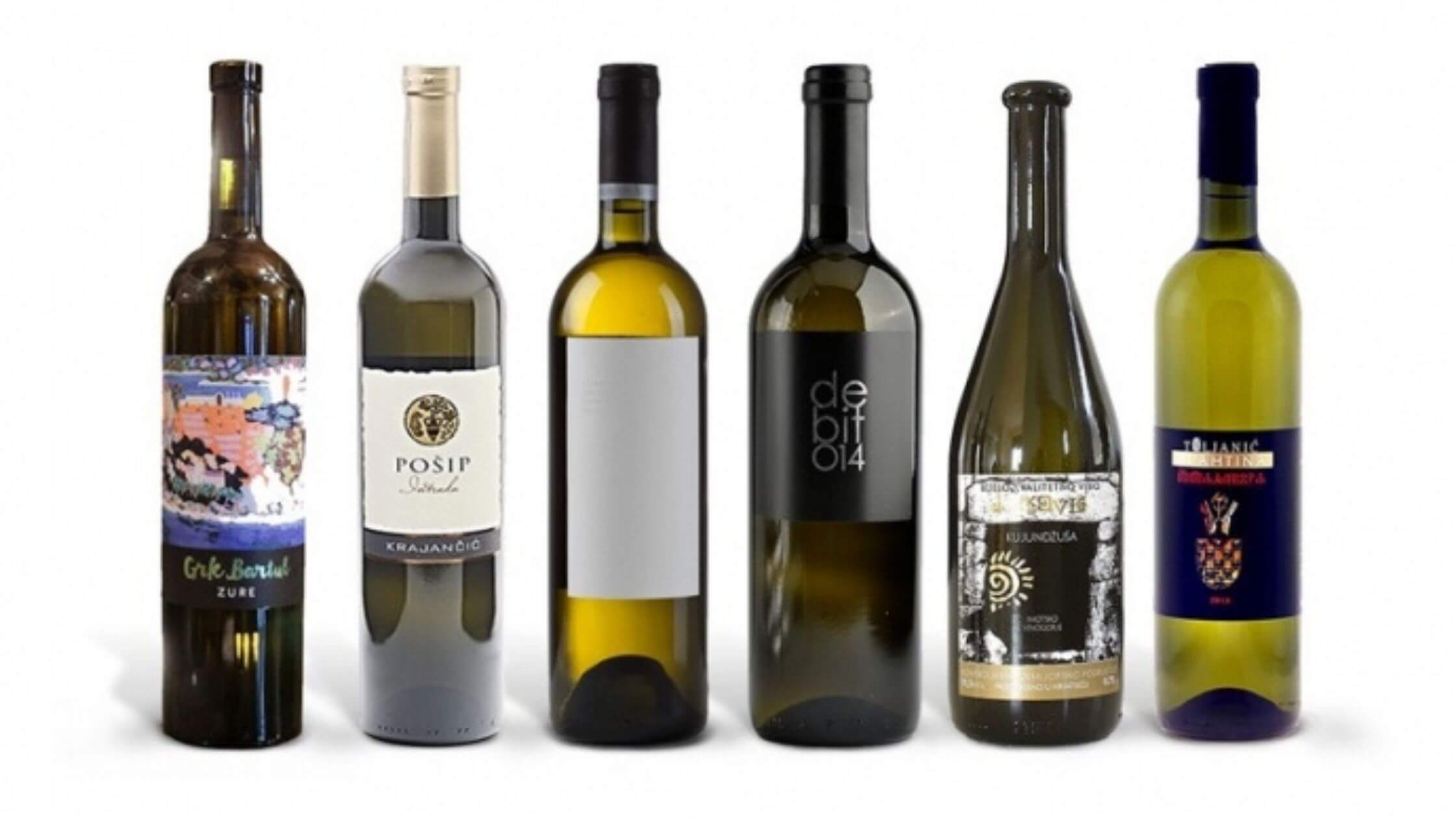
Croatian white wines are extremely refreshing to sip on during warm summer evenings. (Image: Total Croatia Wines/Screenshot)
Pošip – Pošip, with its greenish to deep honey gold hues and floral aroma, is a white-wine grape variety that was almost exclusively grown on the island Korčula and is indigenous to the village of Smokvica.
Pošip became the first white wine variety in Croatia with a protected geographical origin in 1967. In the last 20 years, Pošip cultivation has spread from Korčula to neighboring islands such as Hvar and Brač, as well as along the coast of Pelješac.

White-wine grapes growing on vines that are usually ready for harvest in the Fall. (Image: Pexels)
Pošip grapes are usually harvested in the first week of September, producing wines with a crisp fruity aroma, containing notes of apples, vanilla, citrus, and almonds. Overall, a balanced and elegant wine that pairs well with fish and shellfish, or for slow sipping on warm summer nights.
Grk – Grk is a golden-green, white-wine grape, indigenous to the sandy soils of Lumbarda on Korčula for over 2,000 years. While most wines are self-pollinators, Grk only produces female flowers and requires a male vine (often Plavac Mali) be planted nearby to enable pollination.
As a result, quantities of Grk produced are often quite small (1000 bottles or less per harvest), making this wine a rarity. The local lore is that wine producers used to only keep bottles of Grk for personal consumption, and to share with close family and friends.
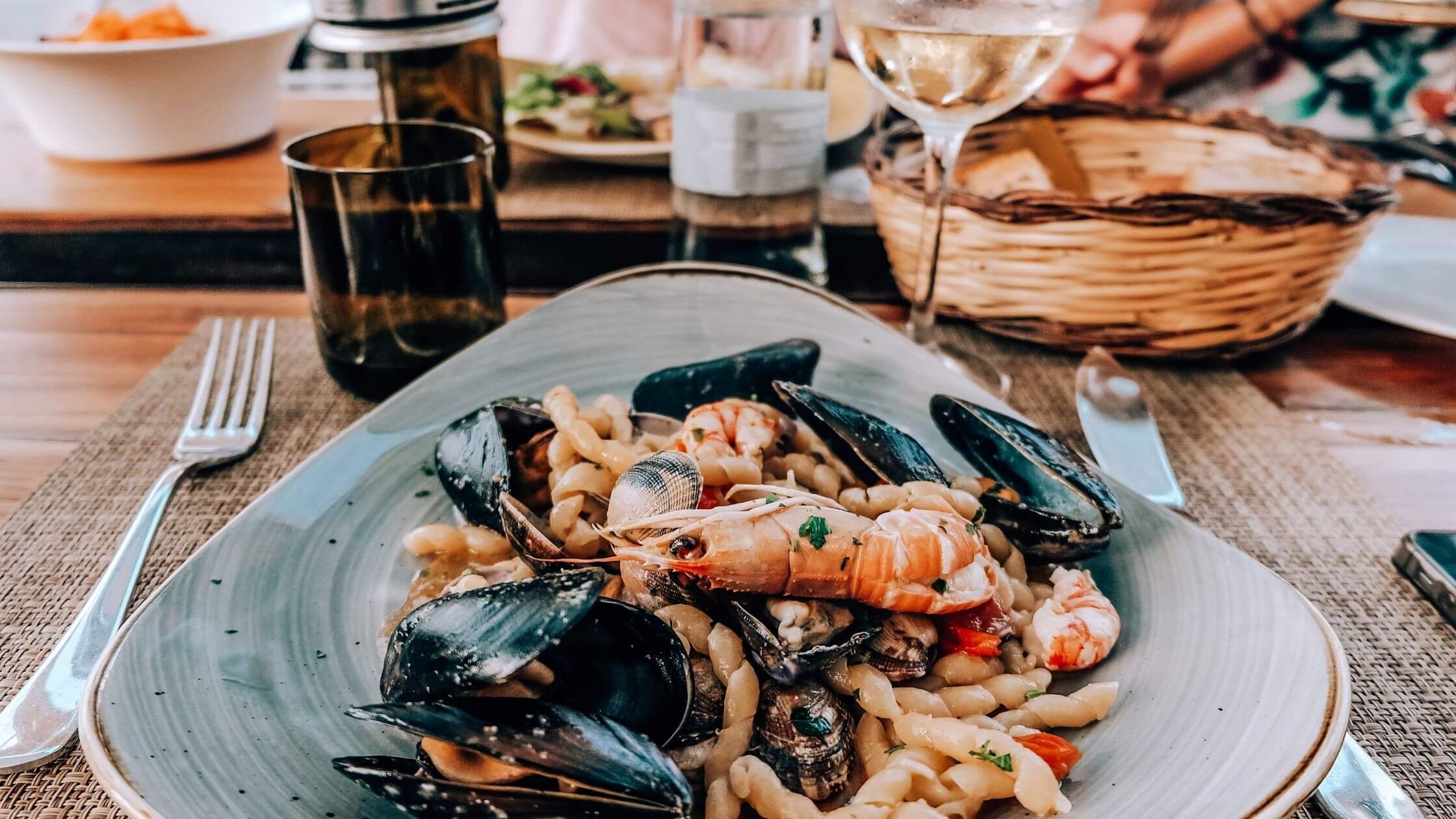
Pair a glass of Croatian wine with fresh seafood. (Image: Pexels)
If you manage to get your hands on a bottle, you’ll find that Grk is a dry white wine that can be adorned with notes of honey, pepper, pear, melon, herbs, and nuts. It pairs well with fish, seafood, chicken, and cold appetizers, but can also be served as an aperitif.
Debit – Another relatively obscure white wine of Dalmatia is Debit, produced from grapes of the same name. Debit is a straw yellow/gold, late-ripening grape variety grown along the northern and Croatian coast. Debit is indigenous to Croatia, but has some tenuous links to varieties in Italy and Turkey.
Why the name “Debit” though? Again, local folklore suggests that the wine’s name is said to date back to the Napoleonic Wars, where Croatian peasants lacked sufficient funds but ensured their safety by paying off French troops in local wine.
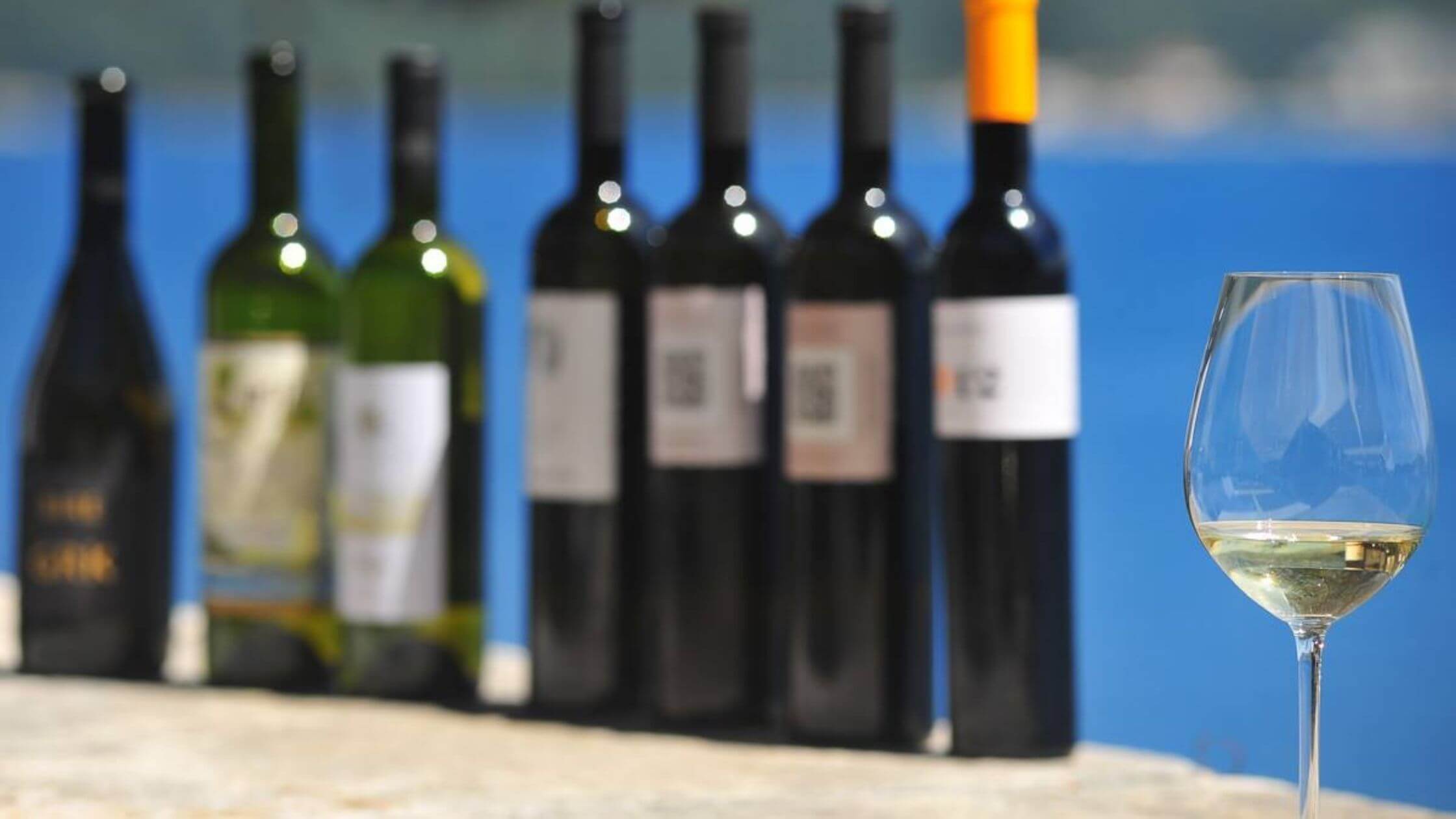
The small island of Korčula produces some of the most well-known white wines in Croatia. (Image: Visit Korčula/Facebook screenshot)
Debit is a fresh, sharp wine with herbal notes and a minerally profile, with some describing the wine to carry hints of limestone and oyster brine. With age, the aromas develop toasty notes like roasted nuts, candied lemons, and browned butter. This wine pairs well with mild seafood, or ingredients like ginger and coconut.
Red wines of Dalmatia
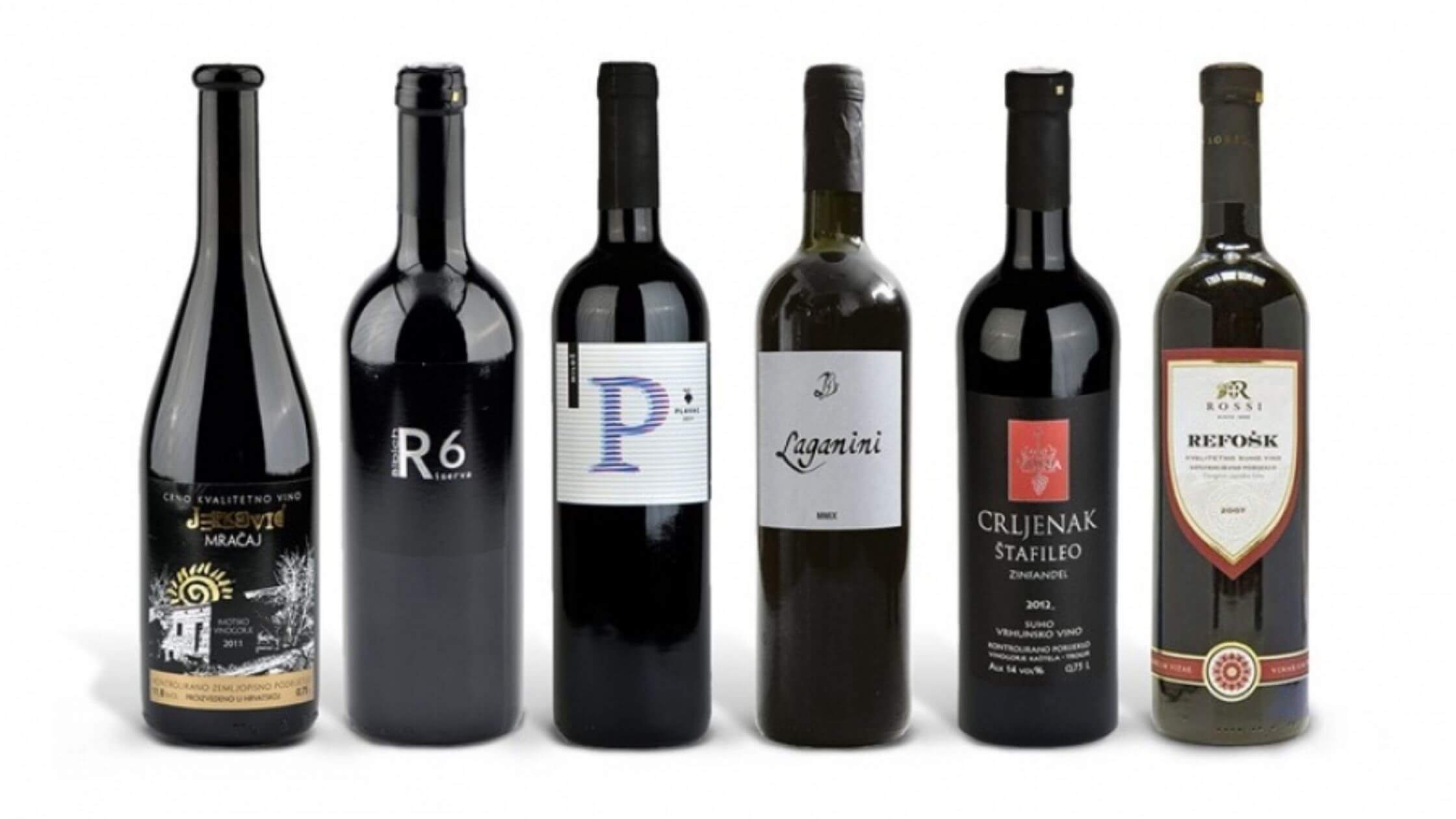
Croatia also produces delicious full-bodied red wines. (Image: Total Croatia Wines/Screenshot)
Babić – Babić grapes are characterized by their blue-red color, with the best quality wine (vrhunsko vino) coming from Primošten vineyards. These grapes are notoriously difficult to grow, with vines often needing a decade or more to reach their full potential, compared to other varieties that may reach that point after 6-7 years.
Upon maturity, vines tend to produce only 3-4 bunches of grapes each harvest due to the harsh soil conditions and intense sun. This leads to more concentrated flavors, imparting bold flavors to the wines.

A Primošten vineyard overlooking the Adriatic. (Image: Njuškalo/Screenshot)
Babić wines are dark cherry red in appearance and full-bodied due to their firm tannins. The most common flavors in these wines are sour cherries, plums, and figs. This wine pairs especially well with hearty tomato-based dishes such as goulash or a rich ragu sauce. It also makes a delicious accompaniment to a hearty steak or pork tenderloin.
Plavac Mali – Plavac Mali or “small blue” in English, gets its name from the appearance of the grapes. It is also the most important and protected Croatian red wine variety, so much so that in 2021, experts from the wine industry dedicated a day to celebrate International Plavac Mali Day.
Like Babić, Plavac Mali has low grape yields which lead to concentrated, rich wines with deep burgundy colors. The “fiery” wine is typically dry, higher in both alcohol (12-17%) and tannins, making it slightly bitter, but with mild acidity. It is also full of ripe fruity flavor with notes of blackberry, cherry, smoke, and spice.
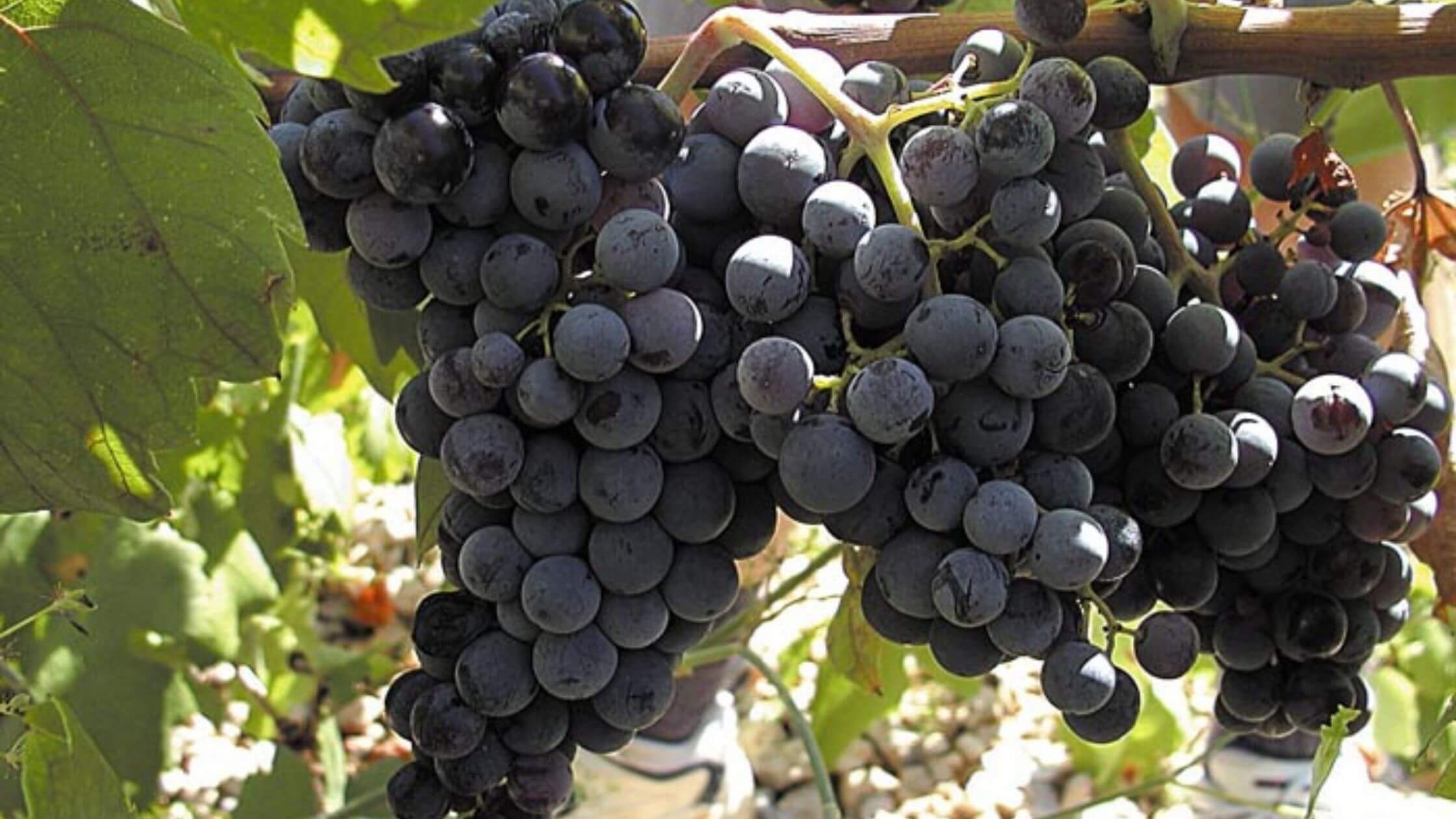
The Plavac Mali grape. (Image: Goran Zdunić/Vinopedia.hr)
This wine pairs well with aged cheese, red meat, and hearty dishes like oxtail stew. A bottle of Plavac Mali would not be out of place at a family BBQ, weddings, or the most luxurious Michelin-starred restaurants in Croatia.
Zinfandel – While Zinfandel is largely known internally as a Californian wine, it was confirmed by researchers in 2002 that its roots are proudly Croatian. Records from the 15th century reflect winemaking from Tribidrag grapes, the variety used to make Zinfandel, on the Dalmatian islands of Hvar and Vis.
Prior to Plavac Mali, Tribidrag grapes were the most abundant red-wine grape in Dalmatia partly due to its tendency to ripen earlier than other varieties. Unfortunately, in the late 19th century, Tribidrag grapes faced extinction due to disease and mildew. An initiative to revitalize Tribidrag production came about in 2001, elevating Zinfandel’s Croatian identity over the next decade.

Croatian red wines tend to pair well with red meats and hearty tomato-based dishes. (Image: Pexels)
Zinfandel wine is a luscious red, with lower tannins than Plavac Mali. It usually carries notes of berries and spices, best paired with cured meats, red meats, and oily fish dishes like tuna.
Croatian wine and grapes are among the best in the world, and you can find more information about them in Total Croatia’s Guide to Croatian Wine HERE.
For more on lifestyle, follow TCN's dedicated page.
Oscars Celebrated with Croatian Wine in Hollywood
March 28, 2022 - The Oscars were celebrated on Sunday night with Croatian wine in Hollywood!
Celebrating the art of filmmaking is supposed to be the key topic of Hollywood's biggest night – the Oscars. While there are a few controversies about this one, no such thing was an issue at Jonathan Baker’s “Oscar is Women” themed viewing party, taking place at the former residence of Warren Beaty. And guess what? Croatia played a key role.
Hollywood’s Entertainment Industry Is Into Croatian Wines
Can you imagine an entertainment party without libations? Of course, not. Croatian wines Pošip and Babić were served to the attendees as they got settled to watch the Oscar night.
“The word got around about the quality wines and the line was long to get to them,” said Ms. Iva Bahunek Modrič, CEO of the Croatian Tourism Board office in Los Angeles, who attended the party with Mr. Larry Namer, the owner of the Entertainment Channel. Mr. Namer has traveled to Croatia and loves the country and its gourmet and wine scene, and this evening he got the bragging rights about the Croatian wines which he has already experienced in Croatia.

Indigenous Croatian wines – a Pošip from the Terra Madre Winery, Komarna Appellation, and a The Dalmatian Dog Babić from the Testament Winery, Šibenik was served to the attendees together with a California Napa Merlot.
“Pošip and Babić are easy to sip and everyone appreciates their structured, yet soft Mediterranean flavors,” added Ms. Modric of Croatian Tourism Board. “Sipping Croatian wine in a foreign country, envokes the scents of Adriatic which transfer people to Croatia. We are excited that Americans are starting to value the indigenous Croatian wines even in the middle of California, which clearly has many wines to be proud of.”
The Jonathan Baker party at his Baker Manor was dubbed the “Oscar is a Woman” party where Jonathan shot a video with Variety Magazine about the concept behind Oscar being a woman. We are sure this brought up a great conversation at the viewing party. But, most importantly for the Croatian community in the US – it was clear to the attendees, which were on Hollywood's whos who list, that Croatian winemaking can stand up to the best of California.
These two wines, Pošip and Babić, represent more than 70 indigenous Croatian wines currently available in the US and shipped to most US states.
For more information about Croatia and the Croatian wines in the US, visit www.Visit-Croatia.org and www.CroatianPremiumWine.com.
For more information on this Hollywood event and other happenings with the Croatian wines, visit @CroatianPremiumWine on Facebook and IG.
Živjeli!
For more, check out our dedicated lifestyle section.
Sixteenth Century Belaj Castle Selling Croatian Wine Successfully
February the 23rd, 2022 - The gorgeous sixteenth century Belaj Castle, brought back to life with a Russian investment, has been selling Croatian-made wine very successfully and without any worries when it comes to timeframes.
As Poslovni Dnevnik/Marta Duic writes, the sommelier vice-champion of Croatia, Josip Oriskovic, presented ten wines from the Dvorac Belaj Winery (from Belaj Castle) at the Wine Club over recent days, three of which were premieres because the wines won't even be placed and available on the market until next week.
Along with the Belaj Castle, which is located within the stunning and dramatic landscape of the Ucka mountain, there are also historical vineyards that were restored back in 2011 by the Russian Belay family.
Namely, the Russian financier Oleg Belay, who has been coming to Umag for years, decided to buy the castle and the property after learning that they bear the same name as their family name, leaving it to his son Zan Belay. The vineyards dotted around the Belaj Castle were soon restored, and today the estate houses a winery, a restaurant and even a proper space for events and celebrations.
“The Belaj Castle has a long history, and today we can boast of 12 hectares of vineyards and an annual production of 35,000 bottles. These are wines of smaller series, aged, and the vineyards and the castle have matured together. Although many point out that this is a Russian story, everything in the vineyard is the work of Croatian hands,'' revealed Oriskovic, adding that without this investment, there would be no restored vineyards to even speak of, much less visit and produce from.
Although most of the vineyard area has been restored, they have retained two acres of old Malvasia plantations and four acres of Chardonnay. The plantations are from the 1960's and it is from these positions that the Malvasia selection is coming along nicely, which will be available soon.
"The Malvasia selection 2019, which is due to arrive on the market next week, is a Burgundy-style Malvasia aged in Slavonian oak barrels of 3,000 litre capacities and has a creaminess to it. The last Malvasia Selection was from back in 2016, it was sold out, there are only about two hundred bottles of it left that are in our archive. As young winemakers, Kozlovic helped us out in the creation of this wine, and Ivica Matosevic helped us in the creation of our sur lie chardonnay from 2014,'' explained Oriskovic, noting that the vineyards are in an ideal position because Ucka protects them from the elements and that there is never fog on their estate.
On two hectares of Belaj Castle land they grow black varieties while everything else is white. In addition to wine production, the event organises various events about fifteen times a year, and they also offer guided tastings in which they nurture an individual approach to the guest. Oriskovic pointed out that the most frequent guests of their tastings are Scandinavians and Poles.
“The most significant investment we had was in the renovation of the vineyards because all twelve hectares were neglected. We're still concentrating on the vineyards, cellars and wines and we 're constantly investing in that. The basement has stone floors and we're the oldest Istrian cellar with a stone floor, and the property also has a tasting room, a wine cellar and a restaurant. Our main export markets are Croatia's immediate region, more precisely Slovenia, Bosnia and Herzegovina and Serbia,'' said Oriskovic.
Today, the beautiful Belaj Castle is known as the only château in all of Croatia, which means that wine production comes exclusively from grapes from the historic vineyards around the castle, and all of the wine is processed and aged right there on the property.
After they founded the Belaj Winery back in 2011, the Russian Belay family has been completely returning production to the cellars of the castle since 2016. Since 2003, theBelaj Castle has been on the register of protected cultural assets of the Republic of Croatia.
It's also worth noting that the viticultural story of the Belaj Castle begins at the end of the 17th century, when the castle passed into the hands of Johann Weikhard von Auersperg (1615-1677), the Prime Minister of the Austrian Empire during the Habsburg Empire. It was he who initially recognised the benefits of the soil and microclimate of this part of Istria and began growing olives and vines there.
For more, check out Made in Croatia.
Sladic Winery From Skradin Finds Popularity in Germany and Sweden
February the 17th, 2022 - The Sladic Winery from near Skradin is impressing foreign visitors to Croatia from across the world with their flavours and their tasting room. The Germans and Swedes are among those who have had an impression left on them thanks to this Croatian winery.
As Poslovni Dnevnik/Marta Duic writes, the Sladic Winery is engaged in the production and cultivation of various indigenous Croatian varieties, they have vineyards in three locations which stretch over six hectares and produce a massive 35,000 bottles a year. The business is run by Joso and his sons Ivan and Marko, and in Plastovo near Skradin, they have a tasting room where guests from all over the world come and taste what they've produced. Ivan Sladic pointed out that the most common foreign guests are French, Americans and British nationals, and although their original market is the rest of Dalmatia, 20 percent of the Sladic Winery's production is exported to Sweden and Germany.
“Growing these vines and wine production has been in our tradition for a long time now and has evolved from generation to generation. The tradition began with my great-grandfather, but for the last 25 years, the Sladic Winery has had bottled bottles of the highest quality wine placed on the market. For us, the past year was challenging and unpredictable and marked by the collegiality of those in the catering and hospitality industry, as well as winemakers, to help get rid of old stocks in this difficult situation,'' said Ivan Sladic.
The Sladic Winery's current focus is on autochthonous varieties and they have as many as ten labels under their belts, and in 2020 they placed one of the first sparkling wines in Dalmatia from the Marastina variety. They believe in this variety the most and started building a business with it, and they make four different products from it - fresh maraschino, sparkling wine, aged wine in wood and dessert wine.
“Our Deorum, a maraschino dessert wine, has a special story behind it. It is produced according to a traditional recipe that is over one hundred years old. We also made a documentary about it, which showcases the entire production process. The maraschino dessert wine meant a lot to our region and was one of the biggest European brands. It was appreciated among people because the production process involved with it is very difficult, only 10 percent of the total amount of grapes is actually obtained, so we can say that it is real nectar in terms of wine,'' explained Sladic, emphasising that this wine was recognised back in 1934 by the Institute of General Pathology and the pharmacology of the Royal University of Zagreb, which approved for maraschino to be used for the preparation of medicines and medicinal wines.
As he added, this is a unique case in this country, and there are few examples in the world of a wine being officially included among medicines. They plan to plant two more hectares of the lasin variety, which thrives exclusively in the area, to place their babic on the market, and to improve the technology in their cellar from the Wine Envelope.
"We care about constantly improving our products in order to achieve the maximum, because our varieties have excellent parameters to be side by side with the world's great wines," they concluded from the Sladic Winery.
For more, check out Made in Croatia.
Increasingly Popular Croatian Sparkling Wines Most Sought After in Germany
December the 31st, 2021 - Croatian wines are extremely popular throughout the world and that isn't really news, but what about Croatian sparkling wines? It seems that the Germans have a real taste for it, with a lot of it being exported there.
As Poslovni Dnevnik/Marta Duic writes, according to the Croatian Chamber of Commerce (HGK), in the first nine months of this year, Croatian winemakers exported 403 hectolitres of sparkling wines worth as much as 870,000 euros.
The main markets for the wine were Germany, where 122 hectolitres worth 471,017 euros went, followed by the Netherlands, then neighbouring Bosnia and Herzegovina and Slovenia. One year earlier, when assessing the first nine months, exports were slightly higher, totalling 457 hl worth a massive 1,173,292 euros.
Growing demand...
The Belje winery is aware that Croatian sparkling wines are an important export asset, and just this week this winery launched a top-quality sparkling white wine - La Belle Grand. As they say from there, their new sparkling wine is a brut style wine, which is one of the most sought after in the world, and is characterised by "beautiful pearls" of many small bubbles.
“This summer, we installed a new line and equipment for bottling Croatian sparkling wines in our winery in an extremely short period of time, in order to expand our range and meet the growing market demands for this category of wine. La Belle Grand is our first sparkling wine prepared just for this year's festive period. With it, we're celebrating the end of the year in which we won 52 medals,'' points out Marijan Knezevic, head of winemaking development at Vina Belje. Another new brand on the market is the Slavonian Enosophia from Fericani.
“In the first year of Enosophia's existence, we achieved some really nice results. Although we've only been present on the market since July, we've distributed almost 16,000 bottles of sparkling wine. For next year, we plan to produce and distribute a total of 77,000 bottles of sparkling wine, Nice to see you, Today Blance and Today rose. Enosophia is a brand that is focused on combining innovative technologies and traditions in the development of new flavours. We create light and modern Croatian sparkling wines, produced by the Charmat method and by following the demands of the market,'' explained Martin Kovacevic, chief oenologist of the Enosophia winery. Their Nice to see you sparkling wine is a combination of Chardonnay and Pinot Noir, and Today blanc is made from the much loved and very well known Croatian Grasevina variety.
"We're currently present in 50 outlets, meaning in restaurants and other catering and hospitality facilities. In the first year, our focus was primarily on presenting the brand here on the Croatian market, but despite that, we've already achieved positive results in terms of exports. Enosophia has been launched on the Japanese market with the sparkling wine called Nice to see you and we expect this trend to continue in the future. Our Croatian sparkling wines under the Feravino brand have also found their fans across many European countries, such as Belgium, the Netherlands, Switzerland and the countries of the more immediate region,'' added Kovacevic.
As he explained, their Today blanc sparkling wine is primarily intended for retail sale, while in the HoReCa channel it is marketed as a ''welcome wine'' or as a wine for the preparation of cocktails. Nice too see you is also available through the HoReCa channel, but can also be purchased through the Enosophia brand website. "As for our plans for 2022, we plan to present the second Today - Today rose, which will be produced from the Frankovka variety, which is the most represented in our vineyards," revealed Kovacevic.
The Pavlomir wine house from Novi Vinodolski also has a few export trump cards under its belt, producing four Croatian sparkling wines in the top category, an impressive 15,000 bottles a year.
For more, check out Made in Croatia.


